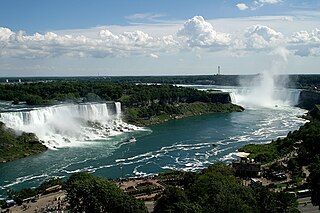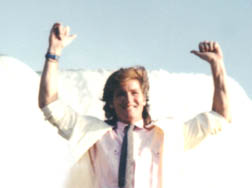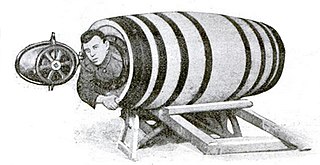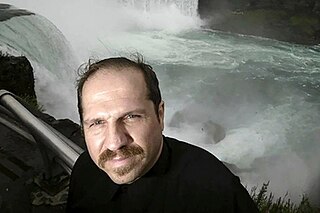
Niagara Falls is a group of three waterfalls at the southern end of Niagara Gorge, spanning the border between the province of Ontario in Canada and the state of New York in the United States. The largest of the three is Horseshoe Falls, which straddles the international border of the two countries. It is also known as the Canadian Falls. The smaller American Falls and Bridal Veil Falls lie within the United States. Bridal Veil Falls is separated from Horseshoe Falls by Goat Island and from American Falls by Luna Island, with both islands situated in New York.
Super Dave Osborne is a character created and played by comedian Bob Einstein. Einstein's comedic depiction was of a naive, although always optimistic, stuntman who was frequently, comically injured when his stunts went spectacularly wrong.

Tightrope walking, also called funambulism, is the skill of walking along a thin wire or rope. It has a long tradition in various countries and is commonly associated with the circus. Other skills similar to tightrope walking include slack rope walking and slacklining.
"Bart the Daredevil" is the eighth episode of the second season of the American animated television series The Simpsons. It originally aired on Fox in the United States on December 6, 1990. In the episode, Bart decides he wants to become a daredevil after watching famous stunt performer Lance Murdock at a monster truck rally.

Annie Edson Taylor was an American schoolteacher who, on her 63rd birthday, October 24, 1901, became the first person to survive a trip over Niagara Falls in a barrel. Her motives were financial but she never made much money from her adventure. She died penniless and her funeral was paid for by public donations.

Lincoln Beachey was a pioneer American aviator and barnstormer. He became famous and wealthy from flying exhibitions, staging aerial stunts, helping invent aerobatics, and setting aviation records.

Steven Trotter was an American daredevil who at age 24 became the youngest person to have gone over Niagara Falls in a barrel. He was one of a few people to perform the stunt twice. He also performed other illegal stunts. He died unexpectedly in 2022.
The Flying Wallendas is a circus act and group of daredevil stunt performers who perform highwire acts without a safety net. They were first known as The Great Wallendas, but the current name was coined by the press in the 1940s and has stayed since.

Bobby Leach was the second person to go over Niagara Falls in a barrel, accomplishing the feat on July 25, 1911 —while Annie Taylor did it on October 24, 1901. He spent six months in hospital recovering from injuries he sustained during the fall, which included two broken knee caps and a fractured jaw. Leach had been a performer with the Barnum and Bailey Circus and was no stranger to stunting. After watching a stuntman die attempting to dive from a platform over 150 feet into a pool 5 feet deep, he made the dive successfully. Prior to his trip over the falls he owned a restaurant on Bridge Street and would boast to customers that anything Annie could do, he could do better.

Karel Soucek was a Czech professional stuntman living in Canada who went over Niagara Falls in a barrel in 1984. He lived in Hamilton, Ontario.

The following events occurred in July 1928:

William "Red" Hill Sr. was a Canadian daredevil and rescuer, born in Niagara Falls, Ontario, in 1888. In 1896 he received his first medal for bravery when he rescued his sister from their burning house which was followed by a life-saving medal in 1912, achieving the status as a local hero. A bootlegger on occasion during the Prohibition, Hill went on to receive a total of four medals in addition to being credited with saving 28 lives and the recovery of 177 accident and suicide victims from the Niagara River just below the Falls.

Nikolas Wallenda is an American acrobat, aerialist, daredevil, high wire artist, and author. He is known for his high-wire performances without a safety net. He holds 11 Guinness World Records for various acrobatic feats, and is best known as the first person to walk a tightrope stretched directly over Niagara Falls. Wallenda walked 1,800 feet (550 m) on a steel cable over Masaya Volcano in Nicaragua, his longest walk, on March 4, 2020.

Oakwood Cemetery in Niagara Falls, New York was founded in 1852 after land was donated by Lavinia Porter. It covers over 18 acres (1 km2) and over 19,000 are buried there. The cemetery was listed on the National Register of Historic Places in 1984.

Charles Stephens or the Demon Barber of Bedminster was an English barber and daredevil. Stephens was the first person to die attempting to go over Niagara Falls in a barrel. He is also the third person and second man to attempt this stunt. A barber living and working in Bristol, Stephens started performing stunts to support his family, which included his wife, Annie, and their 11 children. Charles moved to Ferndale in the Rhondda Valleys where he worked as a barber.
Nathan Boya was the first African American to go over Niagara Falls. Very little is known about Fitzgerald. He claimed to be self-employed, but others have claimed he worked for IBM. On July 15, 1961, Fitzgerald went over the Horseshoe Falls in a metal ball he helped design called the "Plunge-O-Sphere". Performing stunts on the Falls could only be performed with permission, following the death of William Hill, Jr in 1951. Fitzgerald did not obtain a permit to do his stunt and was arrested and fined after completing it. After the flurry of appearances after his plunge, Fitzgerald did not make public appearances until 1985, when he attended Karel Soucek's funeral and in 1988 protesting discriminatory actions against a scientist he called "Dr. X".

Skywire Live with Nik Wallenda is a Discovery Channel special that aired on June 23, 2013. The special was billed as a highwire walk across "the majestic Grand Canyon". Interpretations varied as to whether the actual location – the Little Colorado River Gorge in Navajo territory outside Grand Canyon National Park's borders – was truly part of the Grand Canyon.

Carlisle D. Graham was an American athlete, famous for surviving several journeys through the rapids at Niagara Falls in a barrel and by swimming. Described as the "Nero of Niagara", Graham made his journeys at risk to his own life.

Kirk Raymond Jones was an American who became the first person to survive going over Horseshoe Falls, the largest waterfall of Niagara Falls, without safety equipment, in 2003. He then went over Niagara Falls again in 2017 with a plastic ball and died.















